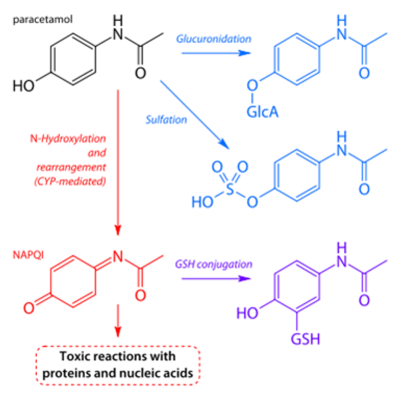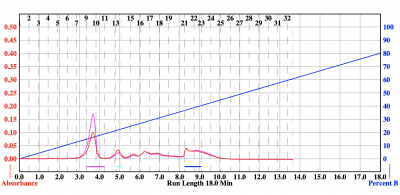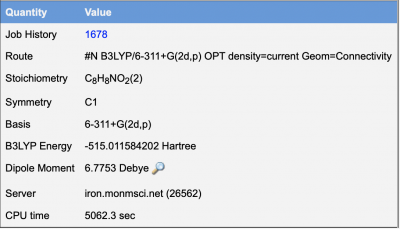Difference between revisions of "Acetaminophen Project"
| Line 25: | Line 25: | ||
|} | |} | ||
| − | |||
| − | |||
| − | |||
| − | |||
==Materials and Methods== | ==Materials and Methods== | ||
Revision as of 22:18, 7 May 2021
Abstract
Acetaminophen(APAP) is an active ingredient in many over-the-counter and prescription painkillers, such as Tylenol and Oxycodone. APAP is also responsible for approximately 50% of the cases of acute liver-failure in the United States and Great Britain(1). Treatments for acetaminophen-induced liver injury(AILI) are limited. The current mechanism for AILI is the production of hepatotoxic NAPQI as a metabolite in an enzymatic, two-electron oxidation(1). However, evidence also supports a one electron oxidation(2). In an effort to reduce the mortality rate of acetaminophen overdose, we are investigating the identity of single-electron oxidation products and their bioactivity as an alternative mechanism for AILI. An oxidation product of APAP was isolated via high performance liquid chromatography (HPLC) and subsequent flash chromatography. The evidence of a radical intermediate was proven via EPR. The dimer was oxidized in order to test bioactivity and a novel product was observed in the resultant chromatography.
Introduction
Acetaminophen(APAP) is an active ingredient in many over-the-counter and prescription painkillers, such as Tylenol and Oxycodone. The mechanism of pain relief has still not been proven thoroughly. The drug essentially works to raise the pain threshold for a person. This means the body requires there be more pain signals in order for the user to feel the pain. One of the players in the complex issue humans deal with called pain are prostaglandins. These are lipid molecules that are made at the site of tissue damage that cause inflammation, and inflammation causes pain. It is worth noting that prostaglandins do many other physiological jobs such as protecting the lining of the stomach. There are enzymes that produce prostaglandins called cyclooxygenases. These enzymes are often the target for analgesics. APAP originally was thought to inhibit prostaglandin formation in the brain, but was later disputed. This was due to the finding that APAP does not suppress PG formation in broken cells, but intact cells. Thus, APAP is regarded as a weak inhibitor of both COX-1 and COX-2 enzymes. However, APAP does not have a harmful effect on the gastrointestinal tract, does not affect platelet function, and does not cause breathing issues in asthmatics and therefor has been theorized to be be a selective COX-2 inhibitor (Hinz, cheremina, and brune "FASEB Journal). Further research showed that APAP is 4.4 times more likely to be selective for COX-2 than COX-1. Since this is the case, long term usage of APAP should be cautioned due to potential cardiovascular issues.
APAP is also responsible for approximately 50% of the cases of acute liver-failure in the United States and Great Britain(1). Treatments for acetaminophen-induced liver injury(AILI) are limited. The current mechanism for AILI is the production of hepatotoxic NAPQI as a metabolite in an enzymatic, two-electron oxidation(1). However, evidence also supports a one electron oxidation(2). In an effort to reduce the mortality rate of acetaminophen overdose, we are investigating the identity of single-electron, oxidation products and their bioactivity as an alternative mechanism for AILI. Currently, there is no effective treatment for AILI. The first step towards achieving this would be to definitively determine the mechanism of acetaminophen metabolite toxicity.
In order to determine the identities and properties of the single electron oxidation products, it is necessary to first synthesize them. The single electron oxidation can be accomplished by using a system of horseradish peroxidase (HRP) and hydrogen peroxide. HRP carries out two, single-electron oxidations of the substrate, APAP in this case. In regard, to acetaminophen the oxidation most likely will take place at the hydroxyl group of the phenol. The single electron oxidations result in the formation of a reactive radical intermediate which can move exist in several different resonance structures.
Pharmacokinetics & Pharmacodynamics
Therapeutic doses in adults range from 1-4 g/day. The minimum lethal dose is 5-15 g, with acute lethal doses ranging from 13-25 g [3]. An Acetaminophen dose of 150 mg/kg causes liver injury. Peak plasma concentrations are seen within 2 hours of ingestion. The half-life is usually 1-3 hours. The metabolites of Acetaminophen stay in the body from 4-5 hours[4]. Hepatotoxicity usually develops 24-36 hours after ingestion, whereas renal insufficiency may develop in 2 to 4 days [5].
Acetaminophen is absorbed from the gastrointestinal tract and exhibits dose-dependent kinetics (first order). Plasma protein binding for Acetaminophen is between 20 and 50%, and passage of the blood-brain barrier is restricted. Elimination of the metabolized drug is though the kidney [6,7].
Metabolism and Excretion
About 90% of acetaminophen is biotransformed by cytochrome P-450 in the liver. Main metabolites are sulphate (about 52%) and glucuronide (about 42%) conjugates. About 4% of the drug is biotransformed to N-acetyl-p-benzoquinoneimine (NAPQI), which is a highly reactive cytotoxic intermediate. NAPQI is detoxified by conjugation with glutathione and excreted in the urine as cysteine and mercapturic acid [6,7].90-100% of an ingested dose is excreted in urine during about 24 h [7]. Approximately 2 % of acetaminophen is excreted unchanged [8].
Materials and Methods
Acetaminophen Sample Prep
Early Acetaminophen Trial Sample Preparation
A 2 mM acetaminophen pH 5 stock solution was prepared in 100 mL of nanopure water. Stock solutions of Hydrogen peroxide (0.413 M), and HRP were created. The experimental solutions of acetaminophen (2 mM), H2)2 (0.25 M, 0.5 M, 1 M, and 2M), and ten uL of horseradish peroxidase was to each of a reaction vial. (NOTE: this method was to visualize the reaction on the HPLC. In order to obtain a more efficient reaction, the method was updated.)
Recent Acetaminophen Trial Sample Preparation
A 50 mM acetaminophen stock solution was prepared in 100 mL of nanopure water. Stock solutions of Hydrogen peroxide (0.413 M), and HRP were created. The APAP was added to a 1:1 water and dioxane solution. The experimental solutions of acetaminophen (50 mM), H2)2 (12.5mM), and ten uL of horseradish peroxidase was to each of a reaction vial. The resulting products were diluted by a factor of 10.
Sample Concentration
The solutions containing our oxidized APAP were spun on a Savant Speed Vac® SC110 with attached Labconco FreeZone 4.5 refrigeration trap for 3 hours until the vials showed a yellow powdery solid at the bottom. The solid was solubilized in lab-grade ethanol in preparation for flash chromatography(2 mL).
HPLC
Reverse phase high pressure liquid chromatography (HPLC) was performed on an Agilent Technologies 1100 Series instrument using a C18 column. The experimental method consisted of a 30-minute long run with mobile phase beginning at 100 percent acidified water to 100 percent 30% volume to volume acetonitrile. UV/Vis spectroscopy was used as a detector for absorbance at 270 nm.
Flash Chromatography
The solubilized and concentrated products were combined and loaded onto a C18 RediSep Rf gold column. The column was loaded onto a Teledyne Isco CombiFlash Rf 200i instrument. The experiment was 18 minutes long and acetonitrile and acidified water were used. The method was arranged so that the mobile phase started at 100% acidified water and increased linearly until it was 80% acetonitrile and 20% acidified water. Once the peaks were all off the column, the run was terminated and the respective vials were collected.
EPR
A 50 mM solution of APAP pH 5 in 1:1 water to dioxane was made and subsequently diluted by a factor of 10. H2O2 (12.5mM) was added to the solution before loading in into a 60 mL syringe. Flow was analyzed at rates of 0.5 mL/minute and 1 mL/minute.
Enzyme Immobilization
An immobilization of peroxidase from horseradish (HRP) was completed using Affi-Gel® 10. This procedure is centered around the isolectric point of the enzyme. The immobilization was completed using a MOPS buffer (pH 7.0) and about 1 mL of Affi-Gel® 10 beads.
Results
HPLC
Flash Chromatography
EPR
Computational Chemistry: Web MO/Gaussian
Web MO/Gaussian is a software containing various basis sets that allow for various levels of computational chemistry.
B3YLP/6-311+G(2d,p)
After running a calculation on Web MO/Gaussian, the following results were reported.
These were the constants used to generate the simulated computational ESR data above in WINSIM. These were found in the raw data output from the geometry optimization of the acetaminophen radical under "Isotropic Fermi Contact Couplings." These are the calculated values that the program found, however the true values cannot be known until sufficient data is gathered from a successful ESR experiment.
| Phenoxy (G) |
|---|
| 2.04 |
| 6.11 |
| 5.73 |
| 1.71 |
| 1.73 |
| 1.36 |
Radical Location
As seen on the electron density map above, the radical spends a lot of time at the ortho positions. To aid with this, the possible resonance structures are shown below.
Knowing this information is important because it helps with predicting which dimer products will form. Certain dimers may be biologically active, which could play a role in hepatotoxicity.
ΔHf Calculations
Below are the calculations of the ΔHf for the formation of a radical of the phenoxyl in acetaminophen. The values listed in Hartree were found doing geometry optimizations using B3LYP/6-311+G(2d,p) basis sets.
- ΔHrxn = ΔHf(Products) - ΔHf(Reactants)
- ΔHrxn = ΔHf[(-OH•) + (H+)]- Hf(-OH)
- ΔHrxn = (-515.01158420 + -0.08303 Hartree) - (-515.480291398 Hartree)
- ΔHrxn = 0.385677198 Hartree = 1012.59556048 kJ/mol
Discussion
Gepasi
We used the software "Gepasi" to analyze the kinetics of the reaction between horseradish peroxidase (HRP) and hydrogen peroxide. This program simulates how the compounds will react with each other. The following link describes how to use "Gepasi":
References
1.) Hinson, Jack A., Dean W. Roberts, and Laura P. James. "Mechanisms of Acetaminophen-Induced Liver Necrosis." Handbook of Experimental Pharmacology Adverse Drug Reactions (2009): 369-405. Web.
2.) Potter, David W., Dwight W. Miller, and Jack A. Hinson. "Identification of Acetaminophen Polymerization Products Catalyzed by Horseradish Peroxidase." Journal of Biological Chemistry 260.22 (1985): 12174-2180. Print
3.) Winek, C.L. (1994) Drug and chemical blood-level data. Winek’s Toxicological Annual, Pittsburgh. Allegheny County Department Laboratories.
4.) Slattery, JT, Wilson, JM, Kalhorn, TF, Nelson, SD. Dose-Dependent Pharmacokinetics of Acetaminophen: Evidence of Glutathione Depletion in Humans. Clin Pharmacol Ther 1987. Apr. 41(4): 413-8
5.) Poisindex, Thomson Micromedex (2005).
6.) Dollery, C. (1993) Therapeutic Drugs, Vol 1 & 2, , ed., London: Churchill Livingstone.
7.) Dart, R.C. ed. (2004) Medical Toxicology, 3rd ed., , Lippincott, Williams & Wilkins.
8.)Haddad, L.M. & Winchester, J.F. (1990) Clinical Management of Poisoningand Drug Overdose, 2nd edn., Philadelphia, PA, USA: W.B. Saunders.
9.) Casarett and Doull’s Toxicology (The Basic Science of Poisons), (1986) Klaassen, C.D., Amdur, M.O., Doull, J., eds., Macmillan Publishing Company.
10.) Lauterburg, B. H., Corcoran, G. B., & Mitchell, J. R. (1983). Mechanism of action of N-acetylcysteine in the protection against the hepatotoxicity of acetaminophen in rats in vivo. The Journal of clinical investigation, 71(4), 980–991. doi:10.1172/jci110853













